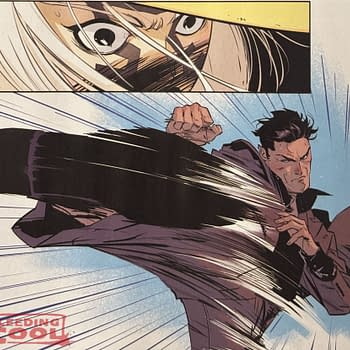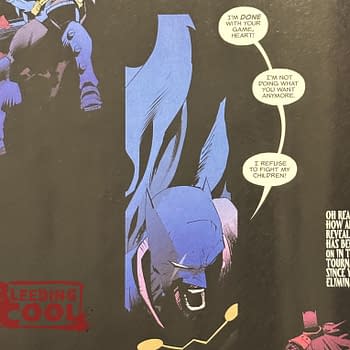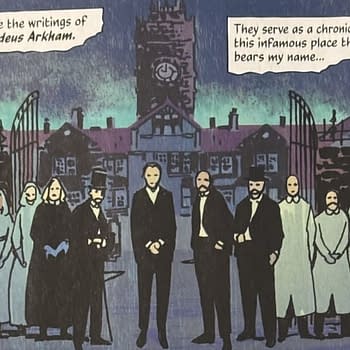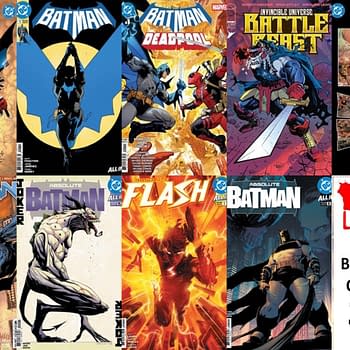Posted in: Comics, Recent Updates | Tagged: Akira Kurosawa, Bokko, Comics, daredevil, dark horse, entertainment, frank miller, Goseki Kojima, Hideki Mori, kazuo koike, lone wolf and cub, manga, New Lone Wolf And Cub, Ronin, rurouni kenshin, sin city, walter simonson
New Lone Wolf And Cub: A Classic Continues – Look! It Moves! By Adi Tantimedh
Adi Tantimedh writes:
[*Warning: Spoilers below!]

The original series is something you probably know by now: a samurai wanders feudal Japan with his young son earning his keep as an assassin-for-hire while waging war against the Yagyu clan, the real power behind the Shoganate. It's considered a classic, spawning several movies and TV series as well as homages in countless movies and anime.
If you care about comics, you want to read New Lone Wolf and Cub. It's a major work by a grandmaster. Koike knows more about storytelling than most writers in their entire lifetimes will ever learn. Volume One alone sets the scene, taking place immediately after the end of the last series, picking up as if no time had passed. The cub survives. A new wolf arrives to take him in his care. A new enemy rises to fill the power vacuum left at the end of the last series. The new wolf has his own mission. A new conflict begins.
New Lone Wolf and Cub is not a nostalgic cash-in but an equally impassioned project by original series creator and writer Kazuo Koike. The original series ended back in 1976. It was first translated into English in the 1980s. Dark Horse published the final, 28th volume of the manga series back on 2002. Koike began writing the sequel series in the late 1990s and I assume Dark Horse waited for the 11-volume series to be completed in Japan before finalizing a deal publish the US edition. Of course, you should read the original series first before you read the sequel.
It's interesting to see how Koike tells the story with seeming ease, reintroducing the world and the son of Itto Ogami, then introducing a new samurai hero Togo Shigekata, who takes Daigoro under his wing and pledges to protect him while on his own mission. Togo is immediately established as different from Itto Ogami's brooding stoicism. His personality is warmer, less grim, but no less devoted to his code. He fights with a different style from Ogami's, and Koike, a martial artist and swordsman in real life, brings his knowledge to depict near-superhuman feats of swordsmanship and makes them look possible. The baby cart is reintroduced and the format of series is firmly re-established.
The series is now the only manga in the West that's a straight samurai story, harking back to the classic, old school historical myth before postmodern series like Rurouni Kenshin came along, which were really about injecting modern contemporary sensibilities into period settings. A lot of samurai manga these days inject modern pop visuals and even fashions into them rather than sticking to period authenticity to appeal to younger, hipper audiences, and the heroes are drawn to look like members of a boy band.
Not so New Lone Wolf and Cub. In the afterword to volume one, Koike talks about mourning the passing of original series artist Goseki Kojima and seeking his widow's blessing before embarking on a search for a new artist. Hideki Mori had finished the 11-volume Bokko, an award-winning (and untranslated) series about a strategist saving cities from invading armies in ancient China, and adapts his style to resemble Kojima's while keeping his own, making the manga feel like it hasn't skipped a beat since the end of the original series. Kojima writes with a yearning for the code of the samurai in a time of war. Koike is not faking it or phoning it in. He's presenting the alien world of feudal Japan and the fanaticism and horror of the samurai code and his admiration for it, even the parts that he knows most people would react to with horror. He invites the reader to share in his fascination with it all, even the violent unfairness of the era.
Lone Wolf and Cub is a major cultural milestone in the East and the West. Much of what we know about Samurai myth and culture comes from the movies and manga on top of the films of Akira Kurosawa. It's also, along with Akira and Ghost in the Shell, responsible for opening up the manga and anime market in the West. As I wrote before, it's also been a huge influence on American comics, bringing a more decompressed, cinematic storytelling style that has found its way to superhero comics after Walt Simonson and Frank Miller read it untranslated back in the 1970s and learn its techniques. You can see the influence in Miller's run of Daredevil, Ronin and Sin City.
And once again, the big comics sites have neglected to talk about New Lone Wolf and Cub, which puzzles me. Is this a sign that the market has moved on or that the other comics sites are just shilling for the Big Two and the movie studios while not bothering to even cover a comic that's been such a huge influence on the whole industry and medium?
Whatever. I'll leave you with the theme to the 70s TV series.
[youtube]https://www.youtube.com/watch?v=R1H7Olxdm6w[/youtube]
Pushing baby carts at lookitmoves@gmail.com
Follow the official LOOK! IT MOVES! twitter feed at http://twitter.com/lookitmoves for thoughts and snark on media and pop culture, stuff for future columns and stuff I may never spend a whole column writing about.
Look! It Moves! © Adisakdi Tantimedh















